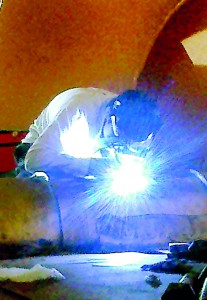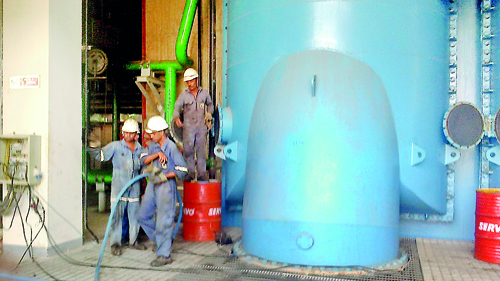News
Indians join Norochcholai coal war
A team from a Chennai-based Indian company that specialises in detecting condenser leaks has arrived in Sri Lanka to inspect the Lakvijaya Coal Power Plant in Norochcholai, said M.C. Wickramasekara, Ceylon Electricity Board’s (CEB) Additional General Manager (Generation).
Mr. Wickramasekara also revealed that the plant’s builders, China Machinery Engineering Corporation (CMEC), have verbally agreed to do a “complete evaluation” of the plant and to take remedial measures.
“They are as worried as we are,” he said. “One of their general managers met me and promised that after the Chinese New Year they will support us to analyse all the faults and to suggest corrective measures.”
Once completed, Lakvijaya will have three units generating 300 megawatts of electricity each. The first was inaugurated in March 2011. Records show that, discounting three maintenance shutdowns, this single plant has been out of commission 22 times between July 2011 and January 2014.
It was shut down again on January 10 — for the third time in five weeks — due to “high conductivity of boiler water”. This is the result of one of the 16,000 pipes transporting sea water to cool the plant springing a leak. It has proved to be a recurrent problem and 105 pipes are already damaged.
In addition to the Indian company contracted by the CEB, CMEC has also contracted a Chinese company to isolate the leak. Specialists from the two countries will work alongside each other over the next few days conducting parallel inspections, Mr. Wickramasekara said.
“In fairness to the Chinese, this is out of warranty but they are attending to it free,” he added. CMEC had previously imported and used ultrasound equipment to locate the cracks after manual searching inside the condenser failed. But the technique adopted by the Indian company is more accurate.
“Ultrasound equipment will show us where the leak is,” Mr. Wickramasekara explained. “The Indian method will also help us determine the condition of the tube and whether its wall has become thinner. This can help us take predictive action.”
The CEB is now in full control of the first unit of the design-build-and-transfer project. Officials say they have insisted that CMEC make modifications to the second unit which is now expected to be available at the end of February. Its boiler was fired for the first time on Friday morning.

The recent breakdown at the power plant was due to a leak in this condenser (above) and (top) a worker attending to repairs yesterday
“We will gradually start the machines and connect it to the system,” Mr. Wickramasekara said. “During this process, we will conduct various tests to see that it complies with requirements. We expect to start commercial operations at the end of next month.”
Among the changes made to the second unit is that all 16,000 pipes in the condenser drum are manufactured in fibreglass, instead of titanium. “We identified corrosion of pipes in phase one,” Mr. Wickramasekara said. “So we have ensured that the second and third units will have fibreglass pipes. We also plan to replace all the pipes of the first unit once the second is operational.”
Unit 2 was expected to be ready in January but is being delayed until all requisite tests are conducted. CEB engineers say they learnt a lesson by “rushing” the first unit under “tremendous political pressure”.
With an increasing number of breakdowns at Lakvijaya, engineers are becoming more transparent about the issues they face. “There are certain things I think we could have done better,” said Mr. Wickramasekara. “It was a learning curve for us, too. We have improved ourselves in phase two.”
“The plant we got is not the best plant we could have got,” he continued. “But at the time it became politically acceptable to have this plant, this (Chinese) was the best solution available to us.” Japanese or Western technology would have been better, he said.
Lakvijaya has commonly experienced failures in its subsystems or auxiliaries, of which it has thousands. “I would attribute some of them to the environment,” Mr. Wickramasekara said. “Perhaps because of the wind pattern, the Norochcholai area has a very corrosive environment. That’s what we and the contractor are learning now.”
A coal power plant was first included in the CEB’s ‘Least Cost Generation Expansion Plan’ in the 1980s. But, first, there was disagreement over where such a project would be sited. Once Norochcholai was decided upon — after considerable delay — it ran up against an environmental lobby backed by the influential Bishop of Chilaw, Rev. Fr. Nicholas Marcus Fernando. By the time President Mahinda Rajapaksa’s administration decided to push ahead, only Chinese funding was available.
The CEB now admits that its engineers may have been insufficiently trained to run the country’s first coal power plant. But they could not prepare well in advance — as they should have — because they did not know to whom the project would be awarded. “The training requirement of a plant is somewhat specific to the technology of the plant,” Mr. Wickramasekara said.
Arjun Deraniyagala, who was CEB chairman from 1996 to 2001, said CEB engineers were experienced in running hydropower plants. “But coal power is a different kettle of fish,” he stressed. “It’s like comparing a buggy cart to a Ferrari. You have to completely reorient your thinking. The expertise that you require is different. Whether the CEB looked into this sufficiently enough, I don’t know.”
Mr. Deraniyagala said, ideally, training should have started during his period. “But we didn’t have any indication where we were going to place the orders,” he pointed out. He said the CEB must strike a proper balance between electrical and mechanical engineers — more of the second category are needed in a coal power plant — and rethink training their engineers.
“Be they electrical or mechanical engineers, they need longer periods of study,” he stressed. “They also need to understudy experienced engineers whom the CEB might need to bring down.”
Mr. Deraniyagala also observed that there were “lots of coal power plants running in China, and they are running well”.
“Each plant has to be tailor made to suit specific conditions,” he said. “Maybe this was not done that way. I don’t know. Maybe certain operational aspects of it require certain expertise that we lack. These are all question marks. In my view, we should have anticipated the problems and prepared for them but I don’t think the CEB were ever involved.”

